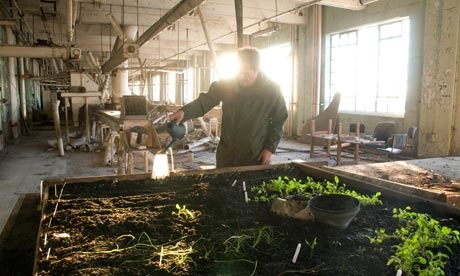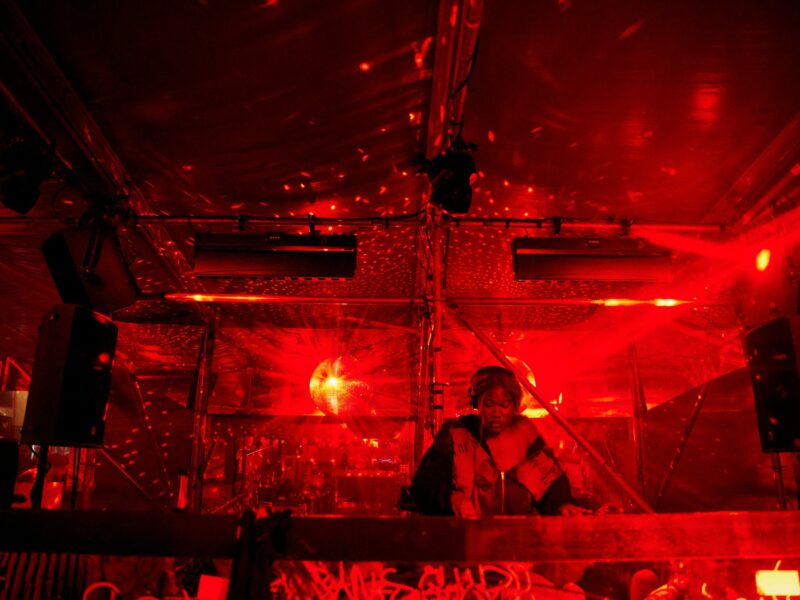
Nick Franglen in ‘Legacy 1’ where he has created a small garden. Photograph: Andrew Hinton
Getting to see Legacy, the new installation by musician and artist Nick Franglen, is an unusually cloak-and-dagger business. Potential appointments come and go until, on the Monday afternoon before the Olympics, Franglen sends me a last-minute text. Can I come to a station in London’s Docklands for 11 o’clock at night? I’m advised to wear boots and dark clothing that I don’t mind being ripped.
The reason for all this subterfuge is the venue: a derelict, partially demolished factory that serves as a document to Docklands’ industrial past. It is dangerous and guarded at the best of times, let alone during the Olympic build-up.
Franglen first came here four years ago with some urban explorers, intrepid types who infiltrate parts of the city that are abandoned and off-limits. The phrase was coined in 1996 and the internet has since enabled a worldwide network of urban explorers to swap stories, photographs and advice. In January, Franglen decided that the building would be the perfect venue for an idea that had germinated two months earlier, when he was asked to design a piece of sound art for the British Business Embassy, a networking initiative, and felt that he had caught a glimpse of “the beast behind the Olympics”.
“I’ve always liked the Olympics,” he says, “but when you’ve got Jeremy Hunt saying we’ve decided not to have an austerity Olympics, we mustn’t hold back, when we’re cutting the School Sports Initiative, that’s an interesting conundrum. Legacy is a ghastly word. Politicians talk about the legacy of the games to east London and I think what they’re concerned about is what their legacy will be. Does east London benefit from all this regeneration or is it negative to have this completely alien infrastructure dropped into it and its heritage stripped out? I was trying to ask a question: what sort of Olympics do we really want? Why does it have to be like this?”
Franglen is a big, garrulous man but clearly has a steely, obsessive streak. Born in north London, he is best-known as half of chill-out duo Lemon Jelly and producer of albums by John Cale and Badly Drawn Boy. In recent years, however, his projects have become more unorthodox. With his band Blacksand, he has played gigs in such unlikely venues as a mine, a submarine and Pyestock, the former Concorde test centre in Hampshire, beloved of urban explorers. He has also played 24-hour solo theremin concerts beneath Manhattan Bridge and London Bridge.
Legacy, however, is his most ambitious and taxing endeavour yet. He had initially hoped to conclude the installation by watching the opening ceremony fireworks from the building’s roof but he has heard rumours that snipers will be stationed there during the games. “I don’t mind playing cat-and-mouse with security but I don’t want to interfere with people doing a serious job,” he says. Also, he adds, “I don’t want to be shot.”
It’s a warm, clear night. We rendezvous in the street and make our way through the outer layer of security. He can never be entirely sure he will get in. “When I approach here my stomach’s churning,” he admits. “I’m white with fear.”
Up close, the building’s hulk looms vast and ghostly. Watching out for security patrols, we negotiate a series of fences and enter through a concealed opening. Inside, it is a disaster area. Several floors are gone. Those that remain are Swiss-cheesed with holes where machinery has been removed, covered by rotting boards too flimsy to support anybody’s weight. A powerful torch might attract attention so we proceed using only the dim light coming through the broken windows. I follow Franglen’s whispered advice: keep close to this wall, mind that loose step, watch out for that 20-foot plunge. “This is not a building to fall over in,” he says. “It’s a shocker. You could fall and kill yourself, of course, but worse than that you could break your leg in the basement where you can’t get a phone signal and no one would ever find you. The first time I came here on my own I found that terrifying, but I feel that this is my domain now. I doubt anyone knows this place as well as I do.”
To safely enter the section that houses Legacy you have to climb a ladder across a dizzying drop and scoot across a stretch of scrub that’s in full view of a mysterious black dirigible that stealthily patrols the waterfront at unpredictable intervals. Finally, there is the so-called “Leap of Faith”. Not, as a rule, having much faith in leaping, I’m relieved to find that it’s actually another ladder. “It doesn’t live up to its name,” agrees Franglen as he clambers down onto the concrete floor. “I call it the Pace of Disappointment.”
The building has a pungent, mushroomy aroma and a series of metal staircases and ladders that make our ascent feel reminiscent of a game of Donkey Kong. One room has no outside wall, so it is plastered with guano and noisy with the sound of pigeons’ wings. Another is carpeted with hundreds of tangled cables. Franglen points to two industrial fans. “They didn’t used to be that close together. Sometimes you notice people have moved things.” Urban explorers endeavour to leave minimal trace – they are trespassers, not vandals or burglars – but Franglen has been here often enough to notice the small things. Like many old buildings, it makes strange noises, as if turning in its sleep and muttering to itself. When you’re not supposed to be there, these noises can sound uncannily like footsteps.
Eventually we reach the seventh floor, which houses Legacy 1. It’s a small garden containing rows of lettuce, spinach, spring onions and radishes, watered by the rain seeping through a hole in the roof. Franglen obtained the seeds from a friend who used to have a plot on the Manor Gardens allotments before they were destroyed to make way for the Olympic Park. That was the easy bit. He used to have to enter the site through a hole in the perimeter fence, and heft sacks of compost across several hundred yards of scrubland. One night he had to climb a tree with two sacks and hide there for four hours. “I used to pray for rain because it meant [the security guard] would stay in his car but, remarkably, it’s always been a night like this.”
In another room we find Legacy 3: a battery-powered television screening a DVD of the opening ceremony of the Athens Olympics. Franglen intended to contrast the triumphal spectacle with the fact that 21 of the 22 venues built for the games now lie empty. “All these buildings in Athens are derelict and guarded and you’re in a derelict, guarded building,” he explains. He turns on the TV. In the gloom and hush it seems deafeningly loud and bright, so he quickly clicks it off again.
Legacy 2 is a low roof filled with shallow water, which Franglen has transformed into a miniature boating lake. He smuggled in 205 solar-powered toy rowing boats – one for each nation competing in the Olympics – and, after much trial and error, successfully waterproofed them. “Sainsbury’s sandwich bags,” he says, proudly holding one up.
We climb another ladder on to the upper roof and I’m suddenly aware that the building is an island of darkness amid a sea of electric light. Behind us lies City airport; to our left the gleaming shells of the Thames barrier; ahead of us the hedgehog spikes of the O2 dome; further to the right the winking eye of Canary Wharf; beyond that the violet glow of the Olympic stadium and the flashing red of Anish Kapoor’s Orbit tower. “It’s just so beautiful up here,” says Franglen, exhaling. “And so quiet, and so secret.”
Such hard-earned views are a key incentive for urban explorers, but Franglen doesn’t consider himself one of them. “I’m not really a group person,” he says. We’re sitting on the roof, conversing in low murmurs, like David Attenborough trying not to spook a herd of antelope. “I like coming to these places at night, which means you see the sunrise and get a sense of the building waking up. It’s about connecting with the space. These spaces talk to you in some way. Once you’ve done it, the world feels like a different place.”
After his first reconnaissance trip in January, he was apprehensive about starting work until, one night, he was on his way back from a gig and spontaneously thought, “Now. Let’s do it now.” He has been coming regularly ever since. His original plan was to finish it by May and leave it as an installation for urban explorers. “I was thrilled by the thought of someone discovering it and going, what the hell is this? They’d take photographs and discuss it and it would grow, the same way the plants are growing.” But the heightened security associated with the Queen’s jubilee and the Olympics has slowed him down and kept most visitors away. Now, he says, this article, and a documentary filmed by a friend, will be Legacy’s only exposure to the public. “It’s been cut off at the knees,” he says sadly.
We hear approaching rotor blades, and crouch, unmoving, beside the low wall that borders the roof. “It’s interesting what one gets scared of,” he continues after the helicopter has passed overhead. “For the past few weeks I’ve woken up every morning with a nightmare and it’s never about being caught. It’s about not being able to get in and complete what I’ve been trying to do.”
I wonder about the kind of person who commits to something like this: all those moments of panic and long hours of solitude. The politics and the artistic challenge don’t quite explain it. “It’s pretty obviously an obsession,” Franglen admits. He used to be a committed motorcyclist until a serious accident in 1998; now he’s into scuba diving and cave diving. The goal is always the liberation that comes from intense concentration, when everything melts away but the task at hand. Legacy has had the same effect.
“There’s been a point to doing it, and the point isn’t just about what’s going on in Stratford. It’s about what’s going on in here.” He taps his head. “Once I’ve delivered that to myself I need to get on with my life. I haven’t had much of a life for the past few months. It’s all I’ve thought about.” He sighs. “I’ve been mauled by it. It should have been so much easier. But I’ve still done it.”
Three days later, Franglen emails me to say that Legacy is finished, the last boat (dedicated to Team GB) waterproofed. Out of the blue, a friend who lived locally asked for a tour and became Legacy’s fourth and final witness. Then Franglen said goodbye to his temporary domain. “It felt like the fitting final celebration,” he writes. “It was always meant to be shared in some way.”
Up on the roof on Monday night, however, he knows none of this. As we stand enjoying the view before our descent, something wonderful happens. The sky above the stadium suddenly explodes with a succession of pyrotechnic blooms: a rehearsal for the fireworks display that Franglen will miss. His face brightens with pure delight. “Isn’t that fantastic?” he says, gazing into the night. “What a gift!”
guardian.co.uk © Guardian News & Media Limited 2010
Published via the Guardian News Feed plugin for WordPress.









